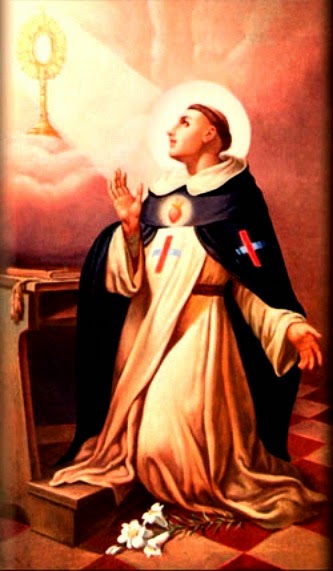Saint of the Day: St. Edmund of Abingdon
 ST. EDMUND RICH was born in Abingdon in Berkshire, England, the oldest son of Reinald and Mabel Rich. The saint attended Oxford University at the age of 12 for the first part of his studies, where he showed early signs of being a genius. After studying grammar there for three years, he was sent to Paris, where he studied arts.
ST. EDMUND RICH was born in Abingdon in Berkshire, England, the oldest son of Reinald and Mabel Rich. The saint attended Oxford University at the age of 12 for the first part of his studies, where he showed early signs of being a genius. After studying grammar there for three years, he was sent to Paris, where he studied arts.While Edmund lived at Oxford, he had consecrated himself to God by means of a vow of perpetual chastity, under the patronage of the Blessed Virgin Mary, in whom, under God, he placed a special confidence; and this vow he kept faithfully his entire life.
During this time, he saw an image of the Mother of God, around which were represented the mysteries of our redemption; and, in the midst of his studies, his frequent prayers to God were so ardent, that he sometimes fell into rapture. He was the admiration of his masters. Because of the purity of his life, he was regarded as a miracle of sanctity.
He interpreted the holy scriptures some time during his studies in Paris and it was his custom to to kiss the Bible every time he held it in his hands.
Edmund lived an austere life. He seldom ate more than once a day, and even then, very little. He slept on the bare floor, or on a bench. After he completed his course in liberal arts and mathematics, and received his master of arts degree, he was employed for six years as a professor of art, mathematics, philosophy, and theology at Oxford. He was known for his scholarship, piety, and skill as a preacher and a writer. While severe to himself, he was gentle and kind towards others, especially to the poor and sick, whom sometimes he personally attended.
In 1222, he was taken away from academic life into Church administration, when he was invited to become a canon and the treasurer of Salisbury Cathedral, which was then being built. He preached the Sixth Crusade in England in 1227 and was consecrated Archbishop of Canterbury in 1234. As archbishop, he firmly defended the rights of Church and State against Henry III, but appeals were carried to Rome over his head and Henry adroitly managed by the authority of the legate to nullify Edmund's power.
When he retired to Pontigny, a Cistercian abbey in Champagne, in the diocese of Auxerre, the saint gave himself up to fasting and prayer, and preached frequently in the neighboring churches.
St. Edmund died at Soissy, near Provins in Champagne, on the 16th of November, 1242, having been archbishop eight years. He was canonized by Pope Innocent V in 1246.
Many miraculous cures have been obtained through his intercession. In 1247, his body was taken up, and found entire, and the joints flexible. His relics remain at the monastery of St. Edmund's of Pontigny.
For more information, go here.




Hi, You might be interested to know that a St Edmund's Church was built in Salisbury in 1269. Although the Church is now an St Edmunds Arts Centre, there is still also a St Edmunds School and a St Edmunds Church Street.
ReplyDelete